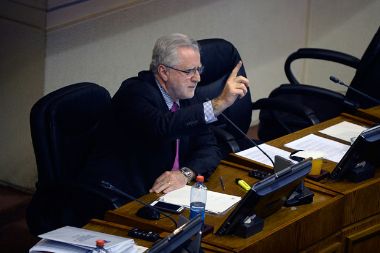
The Ministry of Energy started working with the Catholic University to modify the regulation of the electricity distribution system. It will focus on three areas: energy efficiency, remuneration and smart grids.
Government initiates study and gives 18 months to reform electricity distribution business
A renewed regulatory framework is approaching for the electricity distribution market.
The government has commissioned experts to design a draft bill in 18 months to update the distribution business regulations. The impulse comes after the approval of the law that modifies the transmission market and creates a new coordinating body -promulgated this Monday-, and would affect the market in which companies such as Chilectra, CGE and Chilquinta, among others, operate.
In short, the Ministry of Energy and the National Energy Commission (CNE) opted to implement a model similar to the one adopted for the draft transmission project, which seeks to be “open and participatory”. This consisted of a commission in which state agencies participated, led by the Catholic University of Chile, and led by experts Hugh Rudnick and David Watts.
According to the Government’s request, in 18 months the experts must design a draft bill that includes three pillars to reform the distribution market: changes to the pricing system, incorporation of energy efficiency mechanisms and the inclusion of mechanisms to promote smart grids.
“This July we will launch, in alliance with the Catholic University, a discussion process to modify the regulation of the electricity distribution system (…).We are confident that we will continue working in the same way, with the same spirit of collaboration with the private sector, academia and international organizations, which will allow us to incorporate these elements so that we can provide Chileans with reliable, sustainable, inclusive and reasonably priced energy”, said the executive secretary of the CNE, Andrés Romero, during his inaugural speech at the International Seminar “The Outlook for the Chilean Energy Sector in the short, medium and long term” organized by the World Energy Council (WEC).
This mandate would seek to reform more points than the Government had initially reported, since the Energy Agenda 2014-2018 only included an Energy Efficiency Law, which was expected to be submitted to Congress in the last quarter of 2015.
“This would be within a broader framework that would be to look at the entire distribution, its technical, regulatory and economic aspects, to include a new framework that includes tariff aspects, technological development aspects, expansion and energy efficiency,” explained Hugh Rudnick, an academic and director of the consulting firm Systep.
The interest behind this process would be to “modernize” this segment, which has not been addressed since 1982, when DFL1, the predecessor of the current General Electric Services Law, was enacted.
“We are talking about a standard that has not been revised for 34 years and that has already shown many aspects that we must improve. It is time to think about the distribution of the future, which will have to face a more dynamic market, with intensive residential generation, electric cars, smart homes and exchanges not only of electricity, but also of information associated with it for the benefit of all,” said Romero when asked by PULSO.
The Pillars. Specifically, the future bill seeks to modify the tariff system, which has been criticized by the parties for being “arbitrary”, by averaging the Distribution Added Value study carried out by the authority with the one carried out by the companies.
“We see that the pricing system via Typical Distribution Areas and Model Company lagged behind the standards of objectivity and transparency that now exist in Transmission through the inclusion of the Panel of Experts 12 years ago,” said the executive secretary of the CNE.
Additionally, the project seeks to rethink distribution to serve not only consumers, but also the “consumer producer”, through a dynamic and intelligent network that integrates both traditional consumption and generation as well as its distributed version, electric vehicles and the internet of things.
Finally, the project would include a more efficient management of available resources, integrating people in decision making. “We’re talking about energy efficiency for efficient users, distributed generation for dynamic and mobile consumers, and smart grids for smart users,” he explains.





